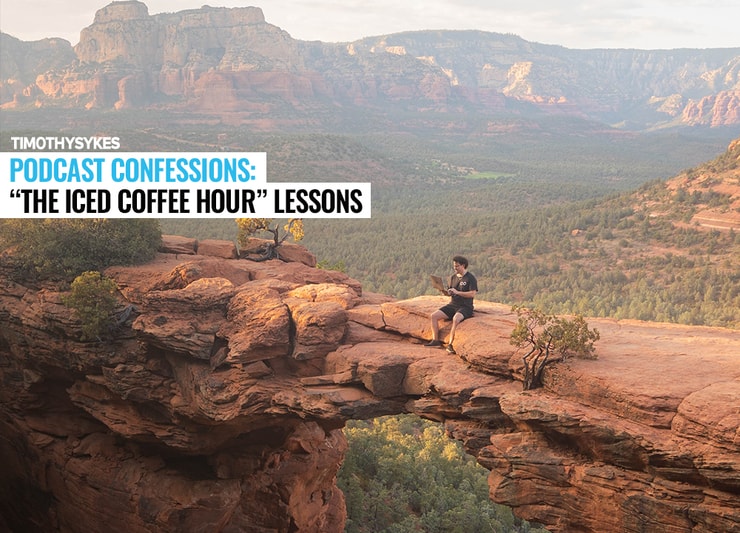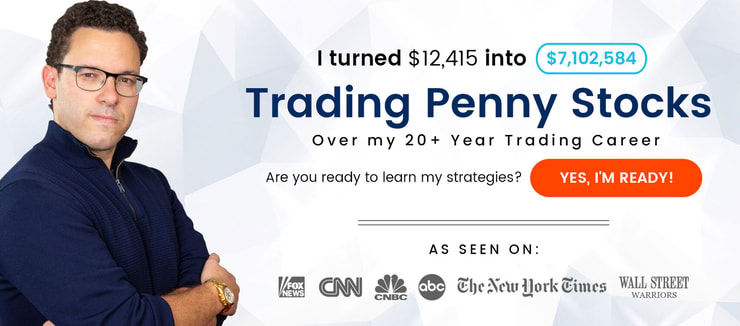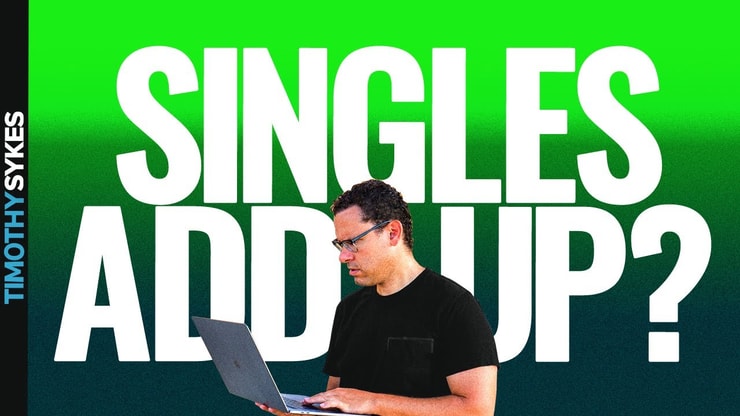I only have two modes: 100% or crashed out. It’s not hard to guess which mode I was in during my guest spot on the podcast “The Iced Coffee Hour.” Lessons abound on trading, life, charity, and what it really means to find your passion.
Maybe you’re already one of my Trading Challenge students and you know my entire story. Or maybe you’re pretty new to my blog and don’t know much about me yet. Either way, you’ll learn a lot about me on this recent podcast feature…
Like who I’m texting at 5:47 a.m. — and what I’m asking them for…
Or how I deal with taxes…
And yep — I’ll even tell you my net worth.
Honestly, one of the biggest reasons you should listen to this podcast is that it’s not 100% about penny stock trading. We talk a lot about things like lifestyle, motivation … and why the right attitude matters.
Believe it or not, ‘successful’ trading isn’t just about making money. It’s about having the right mindset and being able to create a strategy that works for you.
That’s what these “The Iced Coffee Hour” lessons are really about — learning how to define what ‘success’ means to you, and figuring out how to make your dreams a reality.
These lessons definitely apply to trading, but you can really apply them to whatever you want to pursue in life.
Be sure to check out the entire episode on YouTube:
Table of Contents
- 1 About “The Iced Coffee Hour” Lessons and Podcast
- 2 “The Iced Coffee Hour” Lessons
- 2.1 1. Everything Comes Full Circle
- 2.2 2. You’re Never Too Young to Get Started (With Parental Permission!)
- 2.3 3. Don’t Trade Random Penny Stocks
- 2.4 4. Don’t Go All In
- 2.5 5. Cut Losses Quickly!
- 2.6 6. Don’t Get Cocky
- 2.7 7. Every Year Is Different
- 2.8 8. Timing Matters
- 2.9 9. Find a Strategy That Works For You
- 2.10 10. Always Look for Big Gainers
- 2.11 11. Penny Stocks Are Hated — That’s Why I Love Them
- 2.12 12. Charts Matter
- 2.13 13. It’s Not an Exact Science
- 2.14 14. Never Use Market Orders
- 2.15 15. Make Time for Trading
- 2.16 16. Butter Is Delicious
- 2.17 17. Scaling up Doesn’t Always Work
- 2.18 18. Take the Time to Learn
- 2.19 19. People Love a Show
- 2.20 20. Do Good For Yourself … And Others
- 3 Bonus “The Iced Coffee Hour” Lesson: Finding Your Passion
- 4 Even More “The Iced Coffee Hour” Lessons on the Podcast…
About “The Iced Coffee Hour” Lessons and Podcast
First, it’s worth getting to know “The Iced Coffee Hour” podcast. You can find it on pretty much whatever podcast player you use — it’s on YouTube, too.
The podcast is hosted by Graham Stephan, with co-host Jack Selby.
Graham’s a YouTube superstar and a pretty impressive individual. Instead of going to college after high school, he went into real estate in Los Angeles — and made a killing.
He reports that he made his first million by age 26.
On YouTube, he primarily makes videos about entrepreneurship and finance. He’s got a following of 2.54 million…
He paved his own way … he’s definitely not a follower.
Co-host Jack is simply listed as a student on the show bio … But as you’ll see in the podcast, I think he’s got a great future ahead. He’s asking all the right questions, and he’s in good company…
“The Iced Coffee Hour” Lessons
Here are some of the biggest takeaways from the show. Listen and learn!
1. Everything Comes Full Circle
Right before we started recording, Graham and Jack told me the episode had already earned $12,418 worth of ad revenue. I did a double-take because it was almost the same amount I started trading with — $12,415! Cue up “Circle of Life” from “The Lion King”…
2. You’re Never Too Young to Get Started (With Parental Permission!)
Graham shares that he started trading in his teens with his life savings. Hey, I’m a big fan of starting early — I did too! My parents let me start trading with the aforementioned $12,415 of bar mitzvah money — they figured it was mine to lose.
But I didn’t lose it. I turned it into millions.*
A lot of my students started young, too. For instance, my student Grant started trading when he was 15. Now he’s 26. He’s made over six figures in 2020.*
(*These results are not typical. Individual results will vary. Most traders lose money. My top students and I have the benefit of many years of hard work and dedication. Trading is inherently risky. Always do your due diligence and never risk more than you can afford to lose.)
More Breaking News
- NVAX’s Rollercoaster: Clinical Hold and Investigations Rock the Market
- How Affirm Holdings’ Bold Moves in the Market Could Play Out
- Nu Holdings on the Rise: Is It Prime Time for Investor Attention?
3. Don’t Trade Random Penny Stocks
This is one of the key “The Iced Coffee Hour” lessons. When Graham started trading in his teens, he just picked ‘random penny stocks.’ If you trade random stocks, your results will be random.
He shares how early on he was up “$1,500 or 2K” at first … then lost it all. Anyone can get lucky at first. But without a solid strategy or plan, you’ll eventually start losing.
Wanna avoid rookie mistakes like this? Don’t miss my low-cost 30-Day Bootcamp for traders.
4. Don’t Go All In
Another mistake Graham made in his early days of trading? He’d go all in. You don’t have to be a math wizard to figure this one out. If you put all your money on the line, you could lose all your money. It’s not worth the risk. Start small. Aim for singles. Let small gains add up over time.
5. Cut Losses Quickly!
This isn’t just one of the most important “The Iced Coffee Hour” lessons … it’s one of the most important trading lessons, period. If you can’t cut losses quickly, you’re not gonna be in the penny stock game for long. This is my #1 rule!
6. Don’t Get Cocky
Part of what made Graham lose money? He got cocky. He started making money soon after he began trading … It made him feel invincible.
It’s extremely common. I got cocky once … and lost $500K. Learn from my mistakes — read about my big loss in my autobiography, “An American Hedge Fund.”
7. Every Year Is Different
Sure, you can set a goal for how much you want to make in a year. But you’ve gotta remember: not all years are created equal in the stock market.
I’m glad this popped up on “The Iced Coffee Hour” lessons. Check it out…
I made about $125K in 2019. But in 2020, I’ve made over $960K so far.* It’s not because I suddenly got smarter or better at trading. It’s because the opportunities were there and I was ready.
2020 has been a market unlike any other. Wanna know how I’m taking advantage of it? Don’t miss my no-cost “Volatility Survival Guide.”
8. Timing Matters
When I started trading in the late 90s, it was a great time to start trading. But I only recognized that in retrospect. Without even realizing it, I was piggybacking on boiler rooms … before people even knew what boiler rooms were.
I was buying stocks later in the day. And back then, boiler room marketers would call people at dinner time and hype up stocks. This created pileups of orders to be executed in the morning. Then that created huge spikes at the market open. I nailed a lot of plays that way.
And this action led me to the next in line of “The Iced Coffee Hour” lessons…
9. Find a Strategy That Works For You
I say this time and time again: do NOT just follow alerts. It’s not the way to find long-term consistency in the market.
I mean, say that you’re just trading whenever I post an alert. Maybe it works for a while. But what about when I lose? What about if I got hit by a bus? You’d be out of luck. I’m only training wheels — all of my top students worked to adapt my lessons into their own strategies.
10. Always Look for Big Gainers
In the podcast, Graham and Jack ask me how I find the hottest plays.
It’s not black magic. I scan for the biggest gainers with StocksToTrade every day. I’ve also come to rely on STT’s Breaking News Chat tool.
You could try to find hot stocks by yourself … but why? Technology makes it so much easier these days. A good stock screener can help you narrow down the thousands of stocks out there and help you create a manageable watchlist.
11. Penny Stocks Are Hated — That’s Why I Love Them
A lot of people hate penny stocks because they’re sketchy. But I love penny stocks for the same reason. I don’t believe in the companies. But I understand that informational inefficiencies can potentially make them double, triple, or even more in a day. Large-cap stocks don’t really do that.
12. Charts Matter
If there’s a promising catalyst that I think could create a stock spike, I go straight to the stock’s chart on StocksToTrade. I look for specific patterns that I’ve learned how to trade over time. If the pattern’s not there, I don’t bother with it.
13. It’s Not an Exact Science
I wish that it was possible to learn stock market patterns inside-out and then nail every trade. But it’s not.
So this is another important takeaway from “The Iced Coffee Hour” lessons.
Even if the same setup works 100 times in a row, there’s no guarantee that it will work the next time. The stock market’s ever-changing, and there are way too many moving pieces to make the right call every time.
So you’ve got to be flexible, willing to adapt, and ready to cut losses quickly. This is an old tweet, but it’s still true…
Remember that trading is NOT an exact science and if you try to make it one, you're going to blow up like I see too many traders do
— Timothy Sykes (@timothysykes) August 5, 2019
14. Never Use Market Orders
Penny stocks don’t trade after hours, so when there’s a good catalyst, market orders — orders to be executed at the best possible price — can pile up before the market opens. This can potentially create a powder keg right at 9:30 a.m. Eastern.
But if you’re one of the people placing a market order, you could be at the mercy of sudden price spikes. That means you could be paying a lot more than you think…
15. Make Time for Trading
I made my first million while I was still a full-time college student.* If you really want to find your way as a trader, you’ve gotta make time. Wake up early. Stay up late. Make time to study!
11:09pm study check, retweet/favorite this if you're up studying or making your watchlist for tomorrow, or if you made a trade or papertrade on @StocksToTrade today because while big goals take time to achieve, you MUST study/work your butt off EVERY DAY to get closer & closer!
— Timothy Sykes (@timothysykes) November 19, 2020
16. Butter Is Delicious
Just checking if you’re paying attention. But seriously — in the podcast, I talk about how I’d treat myself in the early days … with lobster drenched in butter. I once ate 13 and a half lobsters… True story.
Actually, this might be one of the most important “The Iced Coffee Hour” lessons, and it might explain why I’m not as thin as I used to be…
17. Scaling up Doesn’t Always Work
When I was younger, I thought it was a natural progression to move on from small stocks to big money. But my strategy didn’t scale up in the way I wanted when I started my hedge fund. My fund performed well, but in the scheme of things, I do much better in the penny stock niche.
It was becoming disenchanted with the ‘big money’ world that brought me back to my roots and educating students with DVDs like “How To Make Millions” and my Trading Challenge.
18. Take the Time to Learn
Graham and Jack want to know how long it took for me to ‘get’ trading.
Honestly? Even though I started making money pretty quickly, I’d say it took as long as six, seven, maybe even eight years to really be in a great place with my trading. You’ve gotta be willing to put in the time … and to keep studying!
19. People Love a Show
I used to post pictures of myself with stacks of cash … or with beautiful women … or with my expensive cars. And people loved it.
Honestly, I’ve never been that guy. But it was effective for grabbing the attention of new students. That’s what I really wanted at the time. I’ve definitely changed. I sold my cars. I’m way more focused on my charity and saving the world these days. It’s been my personal evolution.
20. Do Good For Yourself … And Others
I donate all of my trading profits to charity. True story.
My charity, Karmagawa, has done a lot of good work to help save the reef, build schools, and organize a $1 million donation to the people of war-torn Yemen. Why? Because I realize that we’re all in this together. We’ve gotta save the world. Otherwise, we’ll have nowhere to trade!
Bonus “The Iced Coffee Hour” Lesson: Finding Your Passion
I’m married to my job. I work 16–18 hours per day. When Graham and Jack asked me about days off, I was confused … “Days off? Des oeufs? Is that some sort of French thing?”
But seriously. When I’m not trading, I’m making video lessons, teaching, or doing charity. In my spare time, I film documentaries. I love what I do … or maybe I’m just sick in the head. But it doesn’t feel like ‘work.’
Yep, I wake up like this!
Goooooooooooooooooooooooooooooooooooooooooooooooooooooooooooooooooooooooooooooooooooooooooooooooooooooooooooooooooooooooooooooooooooooooooooooooooooooooooood morning! #letsdothis #areyouready
— Timothy Sykes (@timothysykes) November 18, 2020
Even More “The Iced Coffee Hour” Lessons on the Podcast…
These are just a few of the “The Iced Coffee Hour” lessons — you’ll find a lot more in the full episode.
I’m totally transparent about everything — from what I eat to what’s in my wallet to sharing my net worth.
Maybe you’re interested in joining my Trading Challenge and want to feel me out. Maybe you’re just interested in becoming an entrepreneur and want to get in the right mindset. Either way, there are a ton of takeaways in this episode.
When you love what you do and find your goal in life, you find serious drive. Check out the podcast. Get inspired … and get to work!
What are your favorite “The Iced Coffee Hour” lessons? Leave a comment!








Leave a reply